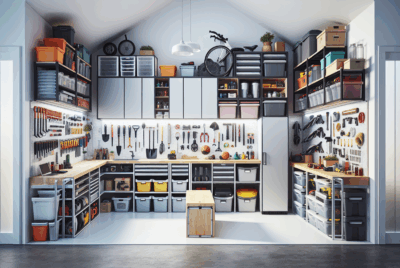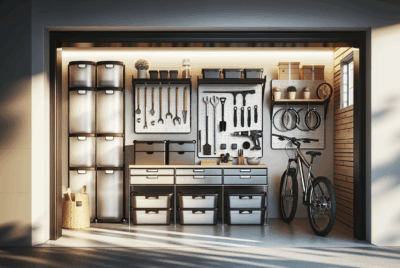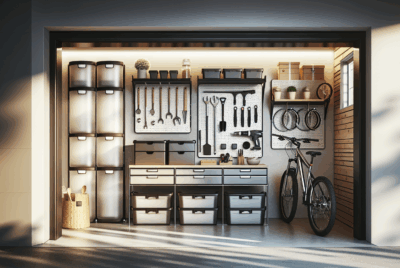Multi-Use Garage: Maximizing Space and Efficiency
As an Amazon Associate, I earn from qualifying purchases, at no additional cost to you. Disclaimer
Transforming your garage into a multi-use space can add both value and functionality to your home. The key to achieving this transformation is organization and creativity.
When I decided to make my garage more versatile, I discovered that careful planning unlocked many possibilities.

I used my garage for more than just parking my car or storing tools. By setting up different zones, I was able to create a workshop and a cozy area for hobbies. This change didn’t just improve how I used the space; it improved how I felt about my home.
By thinking creatively, I helped my garage serve multiple purposes, all without major renovations. It’s amazing how much more vibrant a home feels when all its spaces have a clear role and purpose.
Understanding Multi-Use Garages
Multi-use garages have changed how we think about space. They include historical shifts in design and bring many benefits, like convenience and versatility.
History and Evolution
The idea of a multi-use garage started several decades ago. Originally, garages were only for vehicles. Over time, their role expanded. People saw garages as extra space that could offer more than storage.
As homes got smaller, maximizing space became crucial. Designers began to create garages that supported various activities. Workshops, hobby areas, and even home gyms took shape in these spaces. The rise of do-it-yourself culture pushed this trend further.
Modern design embraces multi-use garages. They include features like built-in shelves, charging stations, and improved lighting. This evolution reflects our changing lifestyle needs. It shows how we use garages not just for cars, but for daily life.
Benefits of Multi-Use Spaces
A multi-purpose garage offers many benefits. One major advantage is flexibility. These garages adapt to different activities like crafting, car repairs, or exercise. This saves time and money by avoiding separate areas for each activity.
Storage is another key benefit. A well-organized multi-use garage can hold tools, sports gear, or seasonal items.
Using smart storage solutions like wall mounts and overhead racks helps keep things tidy.
Lastly, a multi-use garage adds value to a home. Buyers look for homes with practical spaces. This type of garage can make a home more appealing, offering extra functions without a big investment.
Planning Your Multi-Use Garage
When planning a multi-use garage, it’s crucial to determine space needs, consider zoning and permits, and establish a realistic budget. I will guide you through assessing space, adhering to legal requirements, and managing costs effectively to create a functional and organized garage.
Assessing Space Requirements
First, I look at how much space I have. I think about what I want my garage to serve.
Will it be a workshop, storage space, or maybe a home gym?
By listing the main activities, I can figure out how much room each one needs.
Drawing a simple floor plan helps me visualize. I use zones for different purposes.
Storage can be along one wall, while tools for work can be in another area. Shelves and hooks are great for organization, making sure everything has its designated spot.
I also consider vehicle parking space. I ensure there’s enough room for vehicles to park comfortably without cramping any work or storage spaces. Good planning now means less hassle later on.
Zoning and Permits
I check local zoning laws. Each area has rules about garage use. Some may restrict certain activities. Knowing these keeps me out of trouble and ensures my garage meets all legal requirements.
Permits are often needed for major renovations or additions. I visit my local government office or their website to find the specific permits. This is essential to keep my project legal and avoid fines.
It’s also wise to consider safety regulations. Electrical outlets should be in safe locations, and I need to think about proper ventilation if I’ll be working with tools or chemicals. This keeps the environment safe.
Budget Planning
Setting a budget helps me keep costs in check. First, I list all possible expenses, including materials, labor, and any new tools or storage solutions I might need. This gives me a clearer picture of how much I’ll spend.
I balance quality and cost. Sometimes, spending more on durable materials and good organization systems pays off in the long run. I also look for garage design ideas that fit my budget, finding options that don’t compromise on style or function.
Unexpected costs can arise. So, I set aside a little extra money for surprises. Having this buffer ensures I don’t run into financial trouble if something unexpected happens.
Garage Design and Organization

Designing a multi-use garage involves planning. Consider space efficiency, materials, and storage. These elements ensure the garage meets diverse needs.
Maximizing Space Efficiency
When I design a garage, efficient use of space is crucial. I focus on vertical space by installing shelves and wall hooks. This keeps the floor clear.
I sometimes use foldable workbenches to free up space when not in use. Parking space can be increased using ceiling hoists for bikes or kayaks.
Zoning is helpful in separating tasks. I set different areas for cars, tools, and hobbies. This makes it easier to use the garage for multiple purposes without mixing functions.
Choosing the Right Materials
Selecting materials impacts the garage’s durability and look. I prefer sturdy flooring like epoxy-coated concrete, which resists stains and damage.
Wall panels made from pegboard are great for hanging tools, providing versatile storage options.
Climate matters. In colder areas, I use insulated doors to help with temperature control. Proper ventilation is another key factor. It helps in maintaining air quality, especially if the garage is a workspace.
Storage Solutions
Organized storage transforms a garage. I use cabinets for items that should be out of sight, like paint cans and cleaning supplies.
Overhead storage is ideal for rarely used items. Clear bins are handy for quickly identifying contents, and label makers simplify finding things.
Ticket trays or small parts bins help in keeping pieces like screws and nuts sorted. Drawer dividers are great for tool organization, preventing clutter.
Combining these methods ensures everything in the garage has a place.
Converting into a Home Office

Transforming a garage into a home office can be a practical solution for creating a designated workspace. It requires thoughtful design and reliable technology. I will explore how to set up a productive work environment and ensure strong connectivity.
Designing a Productive Workspace
When designing a home office in a garage, I prioritize the use of space. Building custom shelves and storage units can help keep things organized. This reduces clutter and makes the area more functional.
Natural light boosts productivity, so I add windows or skylights if possible. Artificial lighting, such as overhead lights and desk lamps, is important too.
I choose ergonomic furniture, like an adjustable chair and desk, to support long work hours without discomfort. Personal touches like plants or artwork make the space inviting.
Technology and Connectivity
Reliable technology is key in a home office. I ensure a strong Wi-Fi signal by installing a router nearby or using a Wi-Fi extender. This prevents connectivity issues during video calls or large downloads.
I use a good computer setup with sufficient memory and speed for multitasking. This includes a high-quality monitor, webcam, and microphone for virtual meetings.
Adding a power strip with surge protection helps keep devices safe and organized. This setup supports my daily work needs and offers flexibility to adjust as projects change.
Creating a Home Gym

Setting up a home gym in a multi-use garage is a practical way to stay fit. I’ll guide you through choosing the right equipment, flooring, and ensuring good air flow.
Essential Equipment
When building a home gym, I focus on equipment that meets my fitness goals. Dumbbells and kettlebells are versatile. I use them for strength training and adding muscle. A yoga mat is perfect for stretching or floor exercises like sit-ups.
I also consider a resistance band set. They are great for different levels of workout intensity. If I have space, a stationary bike or treadmill helps with cardio. Staying within budget is important. Prioritize equipment based on how often I plan to use it.
Flooring and Ventilation
Choosing the right flooring is crucial for workout comfort and safety. Rubber mats or interlocking foam tiles are excellent. They provide cushioning and protect the floor beneath the equipment.
Proper air circulation keeps my gym comfortable. In a garage, I make sure to have a fan or open windows if possible.
Using a portable dehumidifier helps reduce moisture and keeps the air fresh. Ensuring these elements creates an inviting space where I enjoy working out.
Setting Up an Art Studio
Creating an art studio in your garage can be rewarding. Focus on maximizing natural light and organizing your art supplies for efficient work. It’s essential to make your space both inspiring and functional. Here’s how to do it.
Natural Lighting and Inspiration
I start by examining where light enters my garage, considering windows and existing fixtures. Natural light is crucial for my art, especially during painting sessions.
I choose light-colored paint for walls to reflect light better.
I arrange my workspace to benefit from the sunlight during the day. If windows aren’t enough, I add daylight LED lamps as an alternative to mimic natural light.
Creating a corner with inspiring art or nature images helps ignite my creativity on dull days.
Organizing Art Supplies
Efficient organization starts with a good plan. I categorize my supplies like paints, brushes, and canvases.
I use clear bins to easily see what I’ve stored. Pegboards offer handy vertical space for items I frequently use, like scissors and rulers.
Shelving units help me keep my books and reference materials. Labeling each section ensures a quick finding process, making my art sessions more focused and less cluttered.
Having a tidy space boosts my productivity and keeps me motivated.
Designing a Garage Game Room
Turning a garage into a game room is a fun project. I focus on two main areas: installing entertainment systems and choosing the right furniture and decor.
Entertainment Systems
The first step is choosing a TV or projector. Depending on your space, I decide between a large-screen TV or a ceiling-mounted projector.
Sound systems are next on my list. I look for surround sounds that fill the room with immersive audio. Speakers can be wall-mounted or placed on shelves to save space.
Gaming consoles and devices also play a key role. I ensure there’s enough space for them, along with clear sightlines for optimal enjoyment.
Shelving and cabinets can help organize games and equipment neatly. Wiring and cable management is another aspect I consider essential to keep everything tidy.
Choosing to incorporate streaming devices like Roku or Apple TV is also a solid option to expand entertainment options. These systems allow access to various apps and services, broadening the room’s usability.
Furniture and Decor
The selection of furniture begins with a comfortable seating arrangement.
I prefer options like cozy couches or gaming chairs that provide support during extended play sessions. If space allows, a pool table or foosball table can add extra fun.
Wall paint and lighting make a difference in setting the mood.
Bright LED lights or accent colors give the room energy. I add stickers or posters to personalize the area with favorite game characters or themes.
Next, I think about storage solutions.
Shelves and cabinets help keep controllers and accessories off the floor. Lastly, flooring choices like easy-to-clean mats or rugs can really pull the room together, adding both function and style.
Sustainable Practices
In a multi-use garage, sustainable practices focus on using energy wisely and choosing materials that are kind to the environment. These actions reduce impact and improve the space.
Energy Efficiency
I make sure to incorporate energy-saving features. LED lighting is a simple choice.
These lights use less electricity and last longer. Insulation is also crucial. Proper insulation keeps temperatures stable, which means less heating and cooling.
Solar panels are another great option. They generate electricity from sunlight, reducing dependency on traditional power sources.
Besides solar, motion sensors are helpful for lights. These sensors ensure lights are only on when needed, saving even more energy.
Finally, using energy-efficient appliances and tools in a garage can save a lot of energy over time. Each small change adds up to big savings.
Eco-Friendly Materials
Choosing the right materials makes a big difference. I use recycled materials for shelves and storage, which helps to reduce waste.
Bamboo is another favorite. This fast-growing plant is strong and sustainable.
Low-VOC paints are essential. They release fewer harmful chemicals, making the air cleaner and healthier. Concrete flooring can also be sustainable if it contains recycled content or is made locally to reduce transport emissions.
For insulation, there are options like recycled denim or sheep wool, which offer good performance without harming the planet. Using these materials helps keep the garage eco-friendly.
Final Touches
Adding the final touches to a multi-use garage involves making it both functional and stylish.
I pay special attention to lighting and aesthetics, creating a space that reflects my personal style and serves my needs.
Lighting and Aesthetics
Lighting can transform a garage. I like to use a combination of overhead lights, task lighting, and accent lights.
Bright overhead lights make it easy to see everything, which is great for working on projects or finding stored items.
For task lighting, I choose adjustable lamps near work areas like benches. They offer focused light, helping me avoid mistakes and work efficiently. Accent lights on shelves or display areas add warmth and highlight special items.
Aesthetics are key. I often select paint colors that make the space inviting.
Neutral walls with bold accents provide a clean look. Choosing durable, stylish flooring like epoxy or even rubber tiles can enhance the overall look while being easy to maintain.
Personalizing Your Space
Personalization turns a garage from a storage area into a welcoming multi-use space. I start with function: storage solutions, like wall-mounted racks or cabinets, help keep things organized.
Tools and sports equipment are easily accessible but out of the way.
I add personality with decor. Framed posters, signs, or a pinboard for work goals or family photos gives the garage a unique touch. Repurposing old furniture or adding comfortable seating can make it more inviting.
Finally, I love bringing in a personal hobby. Setting up a small corner for yoga, painting, or a music station can transform the garage into a retreat or creative studio.
Frequently Asked Questions
Multi-use garages offer versatility, combining storage, workspace, and parking. I explore popular layouts, creative design ideas, and cost factors.
Whether converting a single-car garage or deciding between building and buying, it’s important to know the options and costs involved.
What are some popular multi-use garage layout plans?
When planning layouts, I often choose designs that maximize space.
Common plans include workshop areas, storage zones, and parking. Some people combine a gym or studio space with car parking, adding a touch of personalization to the garage.
What creative ideas can I implement in a multi-use garage design?
Incorporating flexible shelving and foldable workbenches can transform a garage. I also like adding a small loft for storage or a lounge area.
Including ample lighting and ventilation can give the garage a fresh and functional feel.
What factors influence the cost of building a multi-use garage?
Costs vary based on materials, size, and labor rates. I find that adding insulation, electrical wiring, and plumbing significantly affects the budget.
Opting for durable finishes and fixtures can increase expenses, but they often lead to long-lasting utility.
Can a single-car garage be converted to accommodate two vehicles?
Yes, I can convert a single-car garage to fit two vehicles by optimizing space.
It often involves restructuring and clearing storage to create more room. Sometimes, expanding the garage or adding a carport is required if space constraints exist.
What is the average cost to construct a 20×20 multi-use garage?
On average, building a 20×20 multi-use garage can cost between $20,000 and $40,000.
The price depends on the materials selected and any custom features added. I always consider factors like local building codes and permits, which can affect the final cost.
Is constructing a new garage more economical than purchasing a pre-built one?
Constructing a new garage allows customization to meet my specific needs, but it can be pricier. Pre-built garages tend to be cheaper upfront.
However, I weigh the value of flexibility and personal design preferences when deciding between the two options.



